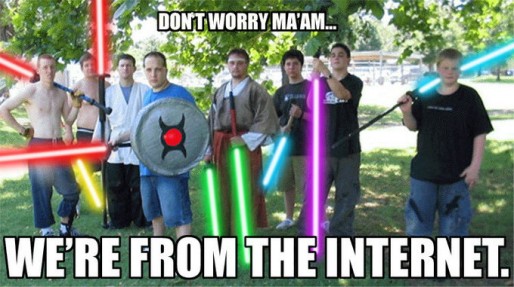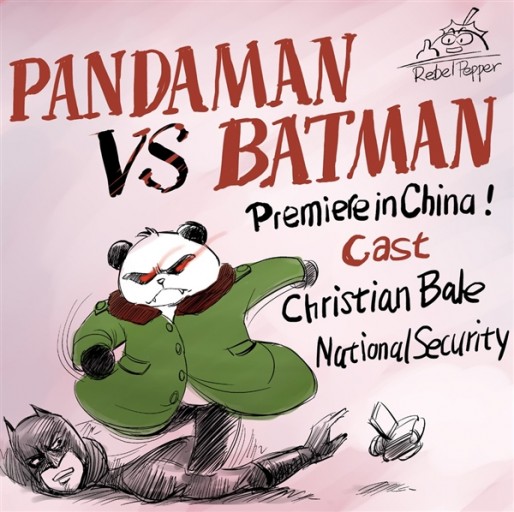What exactly is ROFLCon? According to the organizers:
It was a classic story as old as time: college kids grow up online, decide that it’d be a great idea to throw a internet culture conference, and unleash sheer ridiculousness upon the world.
Back in April 2008, we put on the original ROFLCon — the first internet culture conference devoted to discussing what makes memes work, why they work, and where it’s all going (and then throwing a big-ass rocking party with the internet celebs themselves). It was a kickass time, not to mention the most important gatherings since the fall of the tower of Babel.
We figured we’d keep doing this as long as it remains awesome (and it still is), so we’ve put together several more internet culture events. Will we ever stop? WHO KNOWS?
The conference has become a core part of the Massachusetts Institute of Technology’s festivities, a IRL meetup for internet luminaries and a place for those who love the internet to host conversations about everything from the true nature of anonymous to a rough guide to pwning for the good of mankind.
At this latest (and potentially last) ROFLCon* May 4 and 5 at MIT, which I attended, stories were shared, trolls were baited, and the worst minds on the internet conspired to ruin the Twitter hashtag. In the middle of the chaos, a few gems for journalists emerged.
1. Beyond the Lulz Lies Meaning
ROFLCon is known for exploring the magic of internet memes — seemingly random ideas that become popular.
However, outside of cat antics and cosplayers, there can be more to memes than meets the eye. This year, ROFLCon hosted a panel on Global Lulzes, which had interesting beginnings.
In his keynote at ROFLCon 2, (MIT’s) Ethan Zuckerman reminded us that there’s a whole wide world of internets beyond our anglophone borders. Two years and countless news stories about “internet revolutions” later, we’ve brought Ethan back along with emissaries from the Chinese, Brazilian, and Syrian blogospheres to tell us more. Go forth, young n00b, and learn about the mythical creatures of Baidu, the Brazilian rule 34, and what role memes are playing in the Syrian revolution.
Bia Granja of youPIX showed how Brazilian memes need a variety of factors to become popular. There’s everything from goofy 16-year-olds promising to talk about very serious problems …
… to viral videos that hit on the right amount of ridiculous lyrics, a beat and a dance move to become national sensations (visuals slightly NSFW):
Anas Qtiesh (Global Voices) explained how Syrians used memes during the revolution both to ridicule leaders and spread information, like with this image (via Jillian C. York’s Middle East Memes Guide):
And An Xiao Mina (Digital Artist) created an illuminating presentation on how symbolism in Chinese memes are used to subvert censorship. (Partial panel summary here. For example, this image is actually sharp commentary on an event that made headlines:
So why is this evil panda jumping on Batman? It’s a reference. When American actor Christian Bale (most recently known for playing the title role in the Batman reboot) went to visit Chinese activist Chen Guancheng, he was pushed around by dozens of guards who were placed there to ensure Chen did not violate house arrest. One guard in particular looked like a Panda, hence the moniker, Pandaman. Thus, Pandaman vs. Batman. An Xiao noted that the meme was so popular, Chen actually identified the guard.
While memes may seem like fun and games, they can also be a way to gain insight into a nation’s digital culture — and provide a different lens for understanding current events.
2. Level Up Your Swag
Throwing an event? Think beyond the company pens, jump drives and water bottles that normally line official conference tote/messenger bags. And, please, journalist organizations, stop giving out notepads. At one convention, I received four separate spiral-bound packets of dead tree innards. ROFLCon stepped its game way up by knowing its audience and tailoring the offerings. Starting with the oh-so-hideous-yet-awesome fanny pack (complete with drink holder), attendees received a Choose Your Own Adventure Program, a customized viewmaster, stickers and a button.
The front pocket also contained some surprises: 2 drink tickets and two ROFLcondoms. (Was that a hint?) And if all the fanny-packed goodness wasn’t enough, ROFLCon partnered with local ice cream purveyor to create a Nyancat flavor, based on this meme:
So what does it taste like?
According to Cambridge Day:
[F]ounder Gus Rancatore describes [the flavor] as cherry-flavored Pop-Tarts (just like in Torres’ image of a whimsical space cat) and mukhwas (candy-coated fennel seeds) in vanilla ice cream or vegan coconut sorbet. The flavor was invented for this ROFLcon just as Central Square ice cream shop came up with the flavor Nerds for last year’s conference.
3. Cultivate Space for a Spectrum of Dissent
Far too often, time-stressed journalists default to using a “both sides” model of presenting an issue. This is problematic for a variety of reasons: sometimes, it leads journalists to give airtime to information that is not factual in the name of “objectivity,” and it can lead to a lazy, binary framing of a complex problem. This is particularly easy when writing about technology and policy for an audience that doesn’t follow the issues. Let’s take the Cyber Intelligence Sharing and Protection Act, better known as CISPA. For example, in ABC’s coverage of CISPA, the headline reads “Cybersecurity Bill May Pit Online Safety Against Privacy.” The article follows the usual formula, combining a paragraph about the bill with a quick outline of who is opposed and who is in favor. Topped off with a couple of quotes, the article acts as a placeholder for a much more in-depth article. Post Tech produces a much more detailed version of events, but still works with the two-sides model.
Lifehacker created a fictionalized narrative to illuminate the possible impact of CISPA, but that’s the problem — it isn’t true. The Lifehacker “Explainer” on CISPA is a much better summary of the full bill and it’s potentially negative impacts, but only gives a short paragraph to why a tech company might support the bill. Gawker posts a piece from a consumer perspective, Mashable explains what’s currently happening, Techdirt gets in the weeds of the bill (before declaring it unsupportable). But who else might have something to say about CISPA?
The final ROFLCon panel, called Defending the Internet, featured a tech star line up: moderated by Anil Dash, the panel pulled together Alexis Ohanian of Reddit / Breadpig, Tiff Cheng of Fight For The Future, Derek Slater of Google and Elizabeth Stark of Stanford/Yale to debate the world beyond SOPA/PIPA and take the long view of current threats against the online landscape. Ohanian, Cheng and Stark took the “free internet” position; Slater was more measured, balancing his remarks with a healthy respect for Congress and with an eye toward not demonizing his employer or other large corporations. After some remarks were traded about corporate control of the internet, a figure in blue and white signaled he wanted to speak. A hush fell over the crowd.
It was Tron Guy.
Know Your Meme explains:
Jay Maynard (a.k.a Tron Guy) is an American computer programmer who became internet famous for his homemade electroluminescent costume inspired by the 1982 sci-fi film Tron. Maynard first became a subject of online discussions in April 2004 after uploading pictures of his costume on his website, which quickly spread across tech news sites and humor forums like Slashdot and FARK. Since his rise to stardom as a nerd icon, Maynard has appeared on the late-night talk show “Jimmy Kimmel Live” and remains a regular attendant in many tech-related conference circuits, particularly in advocacy of network neutrality.
 Maynard has argued passionately for net neutrality, but he rose to speak based on a different matter. “I’m a conservative,” he began, “and proud of it!” Then Maynard explained his core issue: that conversations that automatically skewed anti-corporation left out conservatives, who may in fact be in favor of defending the internet. Maynard’s reminder was timely. Internet issues impact a broad constituency, but we normally don’t hear from all the impacted parties. Journalists covering tech issues would be wise to expand their interview circles beyond tech titans, lawmakers, lobbyists, and corporate spokespeople. There are citizens, privacy experts, academics and internet superstars who also have valuable perspectives.
Maynard has argued passionately for net neutrality, but he rose to speak based on a different matter. “I’m a conservative,” he began, “and proud of it!” Then Maynard explained his core issue: that conversations that automatically skewed anti-corporation left out conservatives, who may in fact be in favor of defending the internet. Maynard’s reminder was timely. Internet issues impact a broad constituency, but we normally don’t hear from all the impacted parties. Journalists covering tech issues would be wise to expand their interview circles beyond tech titans, lawmakers, lobbyists, and corporate spokespeople. There are citizens, privacy experts, academics and internet superstars who also have valuable perspectives.
Disclosure: Latoya Peterson attended ROFLCon as a panelist/participant.
(Image Credits: ROFLCon, Know Your Meme, Cambridge Day)






